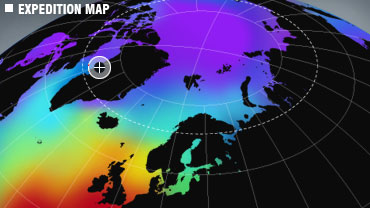About the Expedition
Disko Bay, Greenland
25 September – 6 October 2008
The biggest and fastest glacier in the world
On 26 September 2008 Cape Farewell departed to the Arctic, visiting the spectacular Disko Bay area with over 40 international artists, journalists and scientists. The Arctic is an incredible place for artistic inspiration. By sailing into the heart of the climate debate, we wanted to draw people’s attention to this climatic tipping point.
Musicians Laurie Anderson, Vanessa Carlton, Jarvis Cocker, Feist, Robyn Hitchcock, Ryuichi Sakamoto, KT Tunstall, Martha Wainwright, Luke Bullen, Beatboxer Shlomo, Composer Jonathan Dove, Comedian Marcus Brigstocke, Theatre Makers Mojisola Adebayo, Suzan-Lori Parks, Artists Kathy Barber, David Buckland, Sophie Calle, Jude Kelly, Michèle Noach, Tracey Rowledge, Julian Stair, Chris Wainwright, Architects Francesca Galeazzi, Sunand Prasad, Poet Lemn Sissay, Photographer Nathan Gallagher BBC presenter Quentin Cooper, Senior Lecturer (Open University), Joe Smith, Activist David Noble, Media Executive Lori Majewski and Film Director Peter Gilbert joined Oceanographers Simon Boxall, Emily Venables and Geoscientist Carol Cotterill for a journey to the Arctic and the front-line of climate change.
The ambition of Cape Farewell’s Disko Bay expedition was to inspire the creative team to respond to climate change both in the Arctic and on their return. For 10 days, these artists, scientists, architects, comedians, musicians, playwrights, composers, engineers, film-makers and journalists sailed aboard the science research vessel – Grigory Mikheev, from Kangerlussuaq to Disko Bay upto Uummannaq and back to Kangerlussuaq. The boat visited the front of the Jakobshavn Glacier, one of Greenland’s largest glaciers moving at a faster rate than ever before, losing 20 million tons of ice every day. It was an amazing journey, 10 days of artistic inspiration, debate, discussion and exploration.
The 2008 expedition built on important scientific and artistic research begun in 2007. In 2008, scientists from the National Oceanography Centre, Scottish Association of Marine Science and the British Geological Survey focused on the West coast of Greenland to further explore the continuing northern ice melt.
Dr Simon Boxall and Emily Venables were able to deploy an ARGO float. The new float, Disko-very Bob, was deployed at the beginning of October and is currently sending data back to us on the temperature and salinity conditions in the High Arctic. It is the only active ARGO float in that region and due to make its way to the North West Passage. It will send back data for 3 years and joins the ARGO float the Cape Farewell team deployed during the 2007 expedition.
Dr Carol Cotterill and Dave Smith from the British Geological Survey were able to carry out extensive sequence stratigraphy analysis below the seabed to gain further insight into past climates, changes in sea level and the speed in which these changes can occur. They used sound waves to image the submarine landscape and the team successfully uncovered beautifully imaged deep channels that had become infilled with up to 250m of sediments. They were able to gain data from a variety of settings, and show that the penetration of the sound waves is possible in an area initially thought to be problematic due to the volcanic rocks and also the type of glacial deposits that can be very coarse and difficult to image through. With further work in this area it will be possible to start to piece together a sea-level, glacial retreat / advance story and start to assess the historical impact of climate change cycles.
During the expedition, we fought snow, ice and moving satellite connections to send back daily blogs, images, video footage and audio files. Explore the Disko Bay blog pages to see the firsthand experiences of the crew members.
The expedition followed the Youth Expedition, run in conjunction with British Council Canada, which saw an international crew of 28 young people, educators, artists and scientists sailing to Cape Farewell before crossing to West Greenland and finishing on Baffin Island in September 2008.
View the route › PDF 1.7Mb




